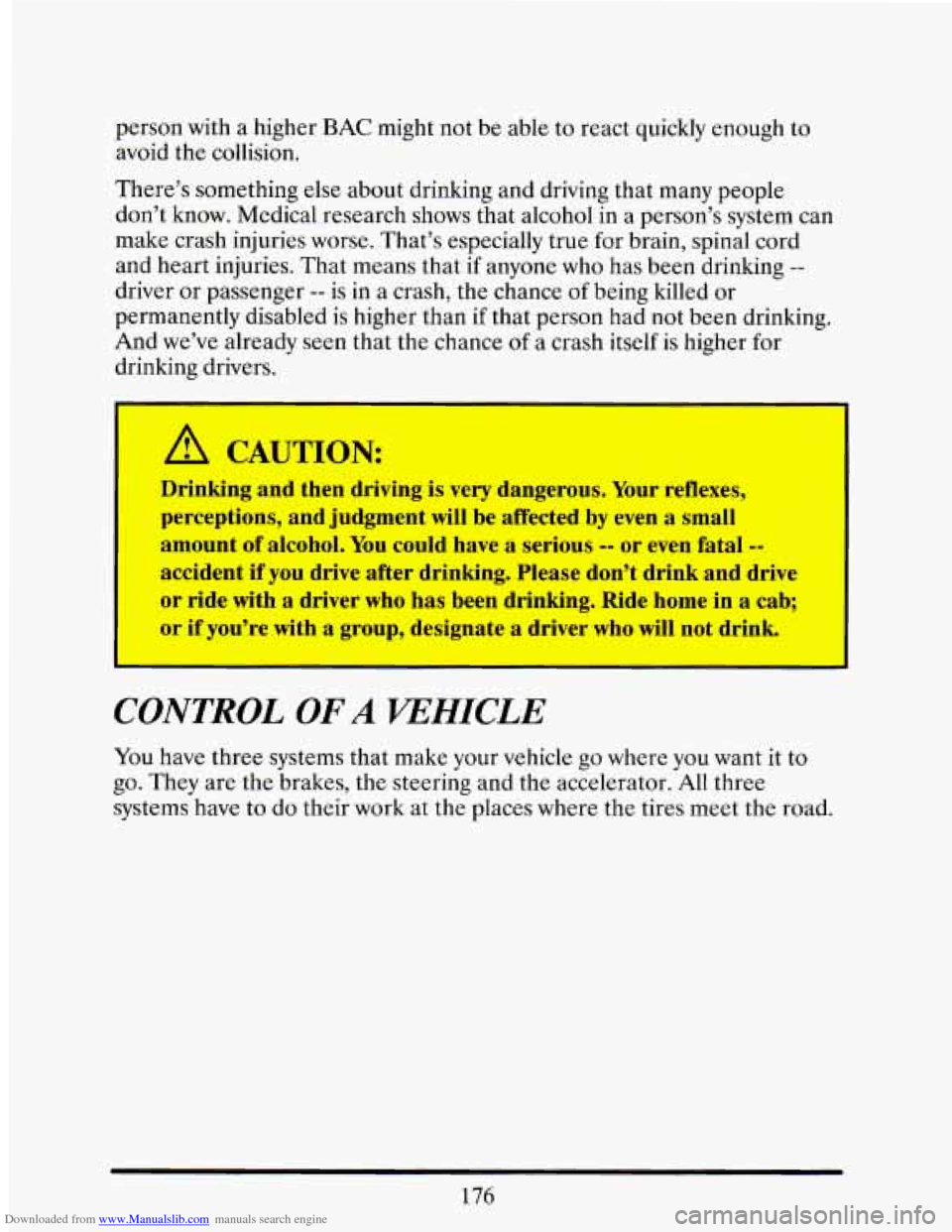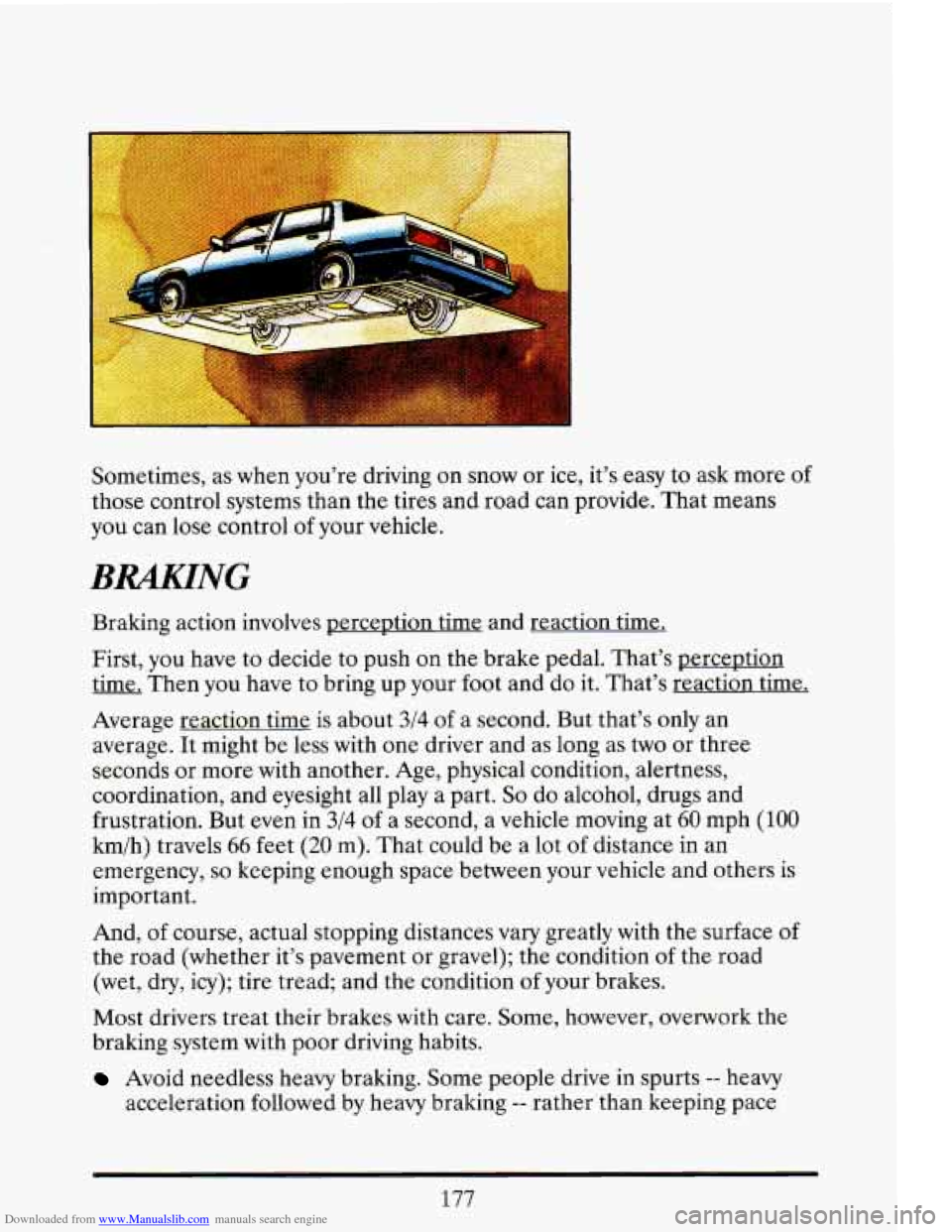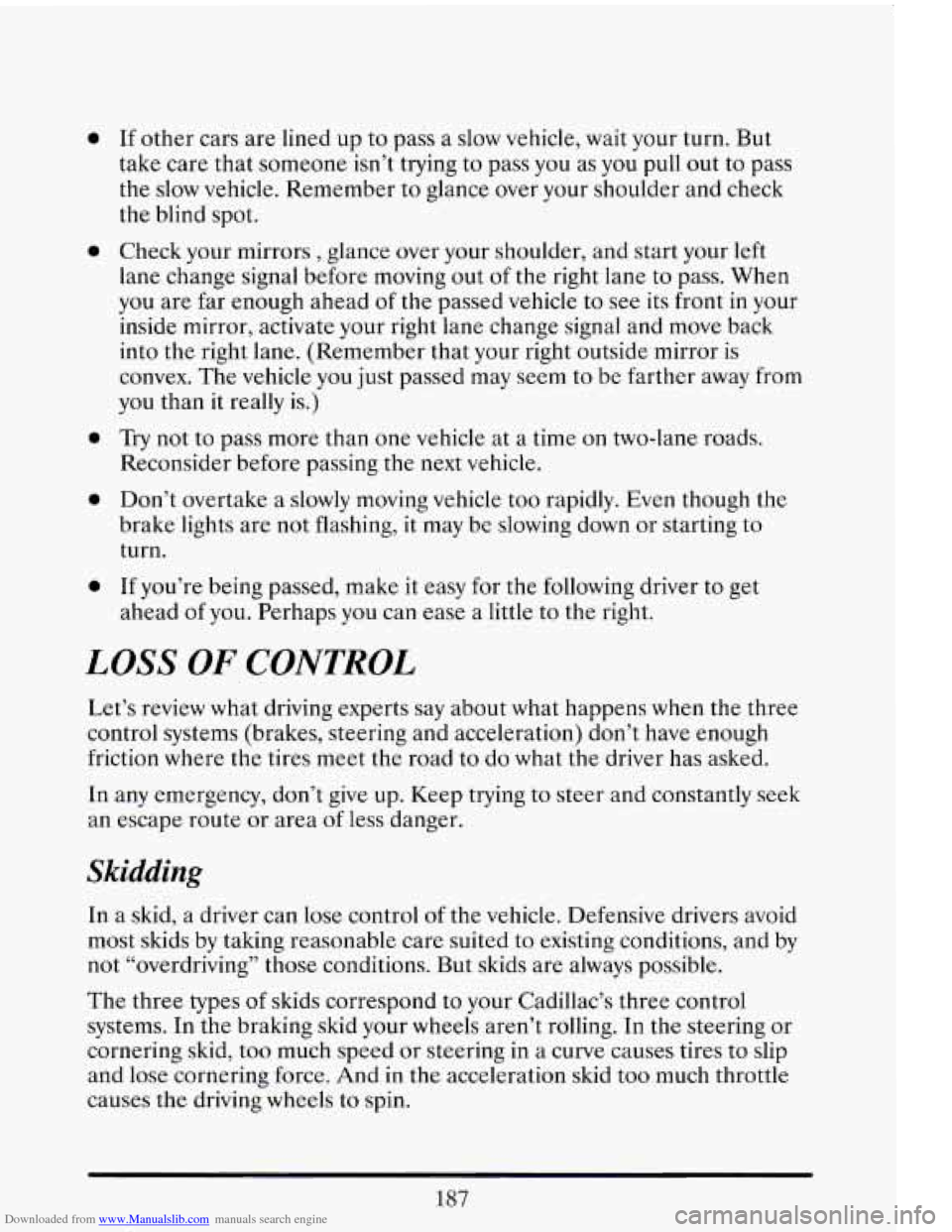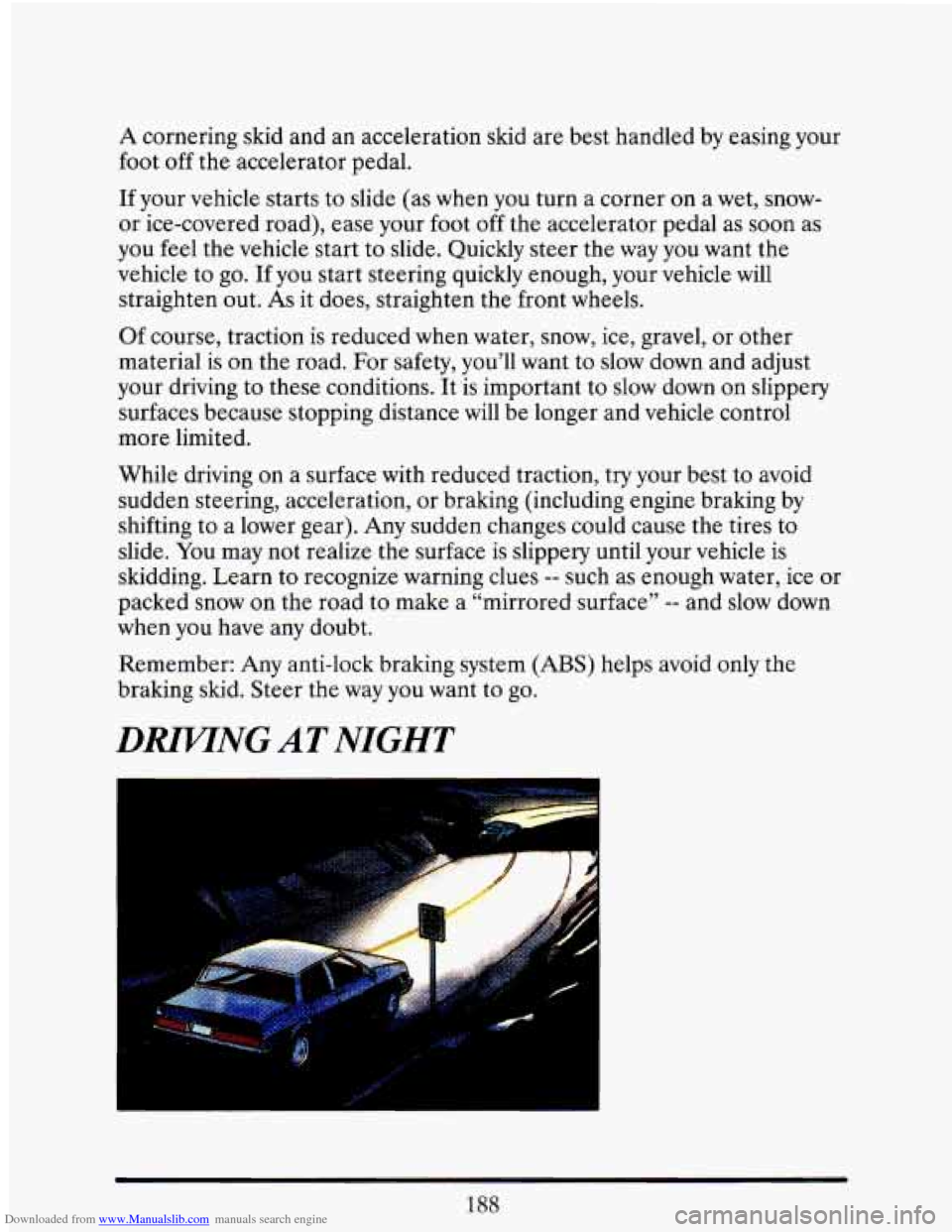1993 CADILLAC ELDORADO tires
[x] Cancel search: tiresPage 9 of 398

Downloaded from www.Manualslib.com manuals search engine . .- 9 --r I I
r
r
P
-. . _.- , -. J. .-
For the 1948 model, Cadillac
introduced the legendary
tail fin
which set the trend in automotive
styling for nearly two decades. This
was followed
by the 1949 model with
the two door hardtop Coupe DeVille
and the modern overhead valve,
high compression
V8 engine.
-
Engineering innovations, con-
veniences and styling dominated the
'50s and '60s. Cruise control, auto-
matic climate control,
tilt and
telescoping steering wheels, twilight
sentinel and four door hard tops all
debuted in these years. In
1957 the
Eldorado Brougham featured ad-
vances such as air suspension, mem-
ory seat, automatic electric
door
locks, transistor radio, a brushed stainless steel roof
and low profile
tires.
introduced in
1953, was redesigned for 1967 as the
first front wheel drive personal lux- ury car. The
472 cu. in. V8 engine
used
in all Cadillacs in 1968 and
1969 was enlarged to 500 cu. in. for
all 1970 Eldorados.
An Air Cushion Restraint Sys-
tem (airbag) was available for
1974,
1975 and 1976 Cadillacs.
Analog Electronic Fuel Injec-
tion was available, on
1975 Cadillacs
and was standard on the new inter-
national size 1976 Seville. In 1978,
the Trip Computer option incor-
porated an on-board microprocessor.
Page 133 of 398

Downloaded from www.Manualslib.com manuals search engine GARAGE DOOR OPENER (OPTION)
This option allows you
to open up to three
garage doors. The transmitter unit fits the
overhead panel.
Your Cadillac dealer can tell you about the hand held power pack unit
and the installation you’ll need at home to make this work.
If your
CadilIac
is equipped with an Electriclear” heated windshield, you’ll have
to be closer to the garage door for the transmitter unit
to work.
FLOOR MATS
If your Cadillac is equipped with rubber-backed front and rear floor mats,
keep them clean by vacuuming and using a spot cleaner,
if necessary. Do
not machine wash.
TRACTION CONTROL SYSTEM (4.4L
NORTHSTAR)
Your traction control system operates only when the system senses that
one or both of the front wheels
is spinning or beginning to lose traction
while driving. This is especially useful
in slippery road conditions. The
traction control system works at all speeds.
It limits wheel spin by using
the antilock and brake systems to apply the front brakes and by shutting
off
fuel injectors to reduce engine torque.
You may be able to spin the tires when accelerating from a standstill on
dry pavement. This is normal. The “TRACTION ACTIVE” message will
119
Page 143 of 398

Downloaded from www.Manualslib.com manuals search engine Tachometer - Analog Cluster
\\' 4 dr
2 5
"1
This gage indicates the
engine speed in
Revolutions Per
Minute (RPM).
. ~~ . -.
NOTICE:
Do not operate the engine with the tachometer in the red area,
or engine damage may occur.
I
Engine Speed Limiter (4.6L Northstar)
If you have the 4.6L Northstar engine, you have an Engine Speed
Limiter. This feature prevents the engine from operating at too\
many
revolutions per minute (RPM). When your engine
RPM,'s are critically
high the fuel supply to the engine is shut off. When the engine speed
slows, the fuel supply will come on again. This helps prevent damage to
the engine.
Vehicle Speed Limiter 4.6 L (270 hp)
This feature prevents your vehicle from exceeding speeds that your tires
are not rated for. When this happens your engine's fuel supply is shut
off.
When the vehicle speed slows, the fuel supply will come on again.
129
Page 190 of 398

Downloaded from www.Manualslib.com manuals search engine person with a higher BAC might not be able to react quickly enough to
avoid the collision.
There’s something else about drinking and driving that many people
don’t know. Medical research shows that alcohol in a person’s system can
make crash injuries worse. That’s especially true for brain, spinal cord
and heart injuries. That means that if anyone who has been drinking
--
driver or passenger -- is in a crash, the chance of being killed or
permanently disabled
is higher than if that person had not been drinking.
And we’ve already seen that the chance
of a crash itself is higher for
drinking drivers.
I
A CAUTION:
Drinking and then driving is very dangerous. Your reflexes,
perceptions, and judgment will be affected
by even a small
amount of alcohol.
You could have a serious -- or even fatal --
accident if you drive after drinking. Please don’t drink and drive
or ride with a driver who has been drinking. Ride home in a cab;
or if you’re with
a group, designate a driver who will not drink.
CONTROL OF A WHICLE
You have three systems that make your vehicle go where you want it to
go. They are the brakes, the steering and the accelerator.
All three
systems have
to do their work at the places where the tires meet the road.
176
Page 191 of 398

Downloaded from www.Manualslib.com manuals search engine Sometimes, as when you're driving on snow or ice, it's easy to ask more of
those control systems than the tires and road can provide. Tha\
t means
you can lose control of your vehicle.
BRAKING
Braking action involves p- and reaction time.
First, you have to decide to push on the brake pedal. That's perception
time. Then you have to bring up your foot and do it. That's reaction time.
Average reaction time
is about 3/4 of a second. But that's only an
average. It might be less with one driver and as long as
two or three
seconds or more with another. Age, physical condition, alertness,
coordination, and eyesight all play a part.
So do alcohol, drugs and
frustration. But even in
3/4 of a second, a vehicle moving at 60 mph (100
km/h) travels 66 feet (20 m). That could be a lot of distance in an
emergency,
so keeping enough space between your vehicle and others is
important.
And,
of course, actual stopping distances vary greatly with the surface of
the road (whether it's pavement or gravel); the condition of the road
(wet, dry, icy); tire tread; and the condition
of your brakes.
Most drivers treat their brakes with care. Some, however, overwork the
braking system with poor driving habits.
Avoid needless heavy braking. Some people drive in spurts -- heavy
acceleration followed by heavy braking
-- rather than keeping pace
177
Page 197 of 398

Downloaded from www.Manualslib.com manuals search engine Steering Tips
Driving on Curves
It’s important to take curves at a reasonable speed.
A lot of the “driver lost control” accidents mentioned on the news
happen on curves. Here’s why:
Experienced driver or beginner, each of
us is subject to the same laws of
physics when driving on curves. The traction
of the tires against the road
surface makes it possible for the vehicle to change its path
when you turn
the front wheels. If there’s
no traction, inertia will keep the vehicle going
in the same direction.
If you’ve ever tried to steer a vehicle on wet ice,
you’ll understand this.
The traction you can get in a curve depends on the condition
of your tires
and the road surface,
the angle at which the curve is banked, and your
speed. While you’re in a curve, speed is the one factor you can control.
Suppose you’re steering through
a sharp curve. Then you suddenly
accelerate.
Those two control systems -- steering and acceleration -- can overwhelm
those places where the tires meet the road and make you lose control.
What should you do if this ever happens? Let up on the accelerator
pedal, steer the vehicle the way
you want it to go, and slow down.
Speed limit signs near curves warn that you should adjust your speed.
Of
course, the posted speeds are based on good weather and road
conditions. Under less favorable conditions you’ll want to go slower.
If you need to reduce your speed as you approach
a curve, do it before
you enter the curve, while your front wheels are straight ahead.
Try to adjust your speed so you can “drive” through the curve. Maintain a
reasonable, steady speed. Wait to accelerate until you are out
of the
curve, and then accelerate gently into the straightaway.
When you drive into a curve at night, it’s harder to see the road ahead of
you because it bends away from the straight beams of your lights. This is
one good reason
to drive slower.
183
Page 201 of 398

Downloaded from www.Manualslib.com manuals search engine 0
a
0
a
0
If other cars are lined up to pass a slow vehicle, wait your turn. But
take care that someone isn’t trying to pass you as you pull out to pass
the slow vehicle. Remember to glance over your shoulder and check
the blind spot.
Check your mirrors
, glance over your shoulder, and start your left
lane change signal before moving out
of the right lane to pass. When
you are far enough ahead
of the passed vehicle to see its front in your
inside mirror, activate your right lane change signal and move back
into the right lane. (Remember that your right outside mirror is
convex. The vehicle
you just passed may seem to be farther away from
you than it really is.)
Try not to pass more than one vehicle at a time on two-lane roads.
Reconsider before passing the
next vehicle.
Don’t overtake
a slowly moving vehicle too rapidly. Even though the
brake lights are not flashing, it may be slowing down or starting to
turn.
If you’re being passed, make it easy for the following driver to get
ahead of you. Perhaps you can ease a little to the right.
LOSS OF CONTROL
Let’s review what driving experts say about what happens when the three
control systems (brakes, steering and acceleration) don’t have enough
friction where the tires meet the road to do what
the driver has asked.
In any emergency, don’t give up. Keep trying to steer and constantly seek
an escape route or area
of less danger.
Skidding
In a skid, a driver can lose control of the vehicle. Defensive drivers avoid
most skids by taking reasonable care suited to existing conditions, and
by
not “overdriving” those conditions. But skids are always possible.
The three types
of skids correspond to your Cadillac’s three control
systems. In the braking skid your wheels aren’t rolling. In the steering or
cornering skid, too much speed
or steering in a curve causes tires to slip
and
lose cornering force. And in the acceleration skid too much throttle
causes the driving wheels to spin.
Page 202 of 398

Downloaded from www.Manualslib.com manuals search engine A cornering skid and an acceleration skid are best handled by easing your
foot
off the accelerator pedal.
If your vehicle starts to slide (as when you turn a corner on a wet, snow-
or ice-covered road), ease your foot off the accelerator pedal as soon as
you
feel the vehicle start to slide. Quickly steer the way you want the
vehicle to go.
If you start steering quickly enough, your vehicle will
straighten out. As it does, straighten the front wheels.
Of course, traction is reduced when water, snow, ice, gravel, or other
material is on the road. For safety, you’ll want to slow down and adjust
your driving to these conditions. It is important to slow down on slippery
surfaces because stopping distance will be longer and vehicle control
more limited.
While driving on a surface with reduced traction, try your best to avoid
sudden steering, acceleration,
or braking (including engine braking by
shifting to
a lower gear). Any sudden changes could cause the tires to
slide. You may not realize the surface is slippery until your vehicle is
skidding. Learn to recognize warning clues
-- such as enough water, ice or
packed snow
on the road to make a “mirrored surface” -- and slow down
when you have any doubt.
Remember: Any anti-lock braking system
(ABS) helps avoid only the
braking skid. Steer the way you want to go.
DIWTNG AT NIGHT
188